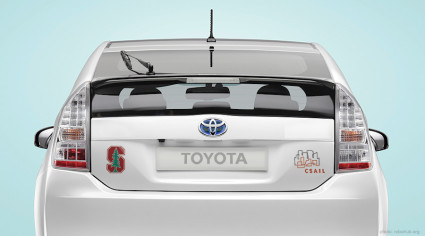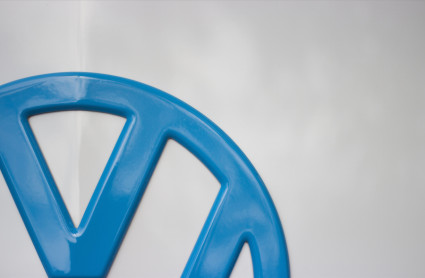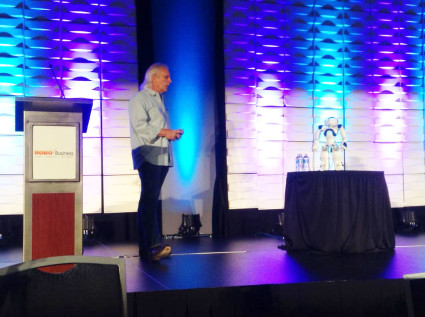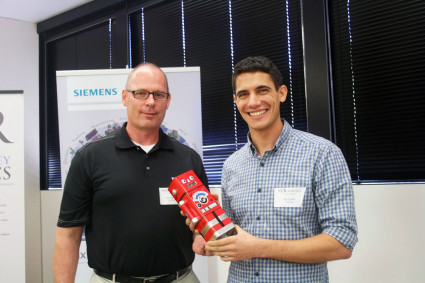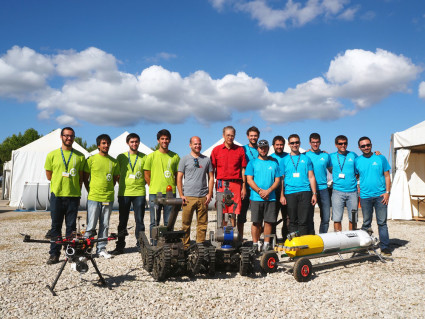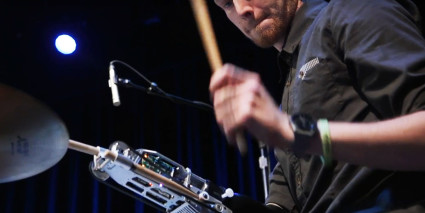
Robohub.org
Robohub Digest 09/15: Big brands, and cozying up to robots
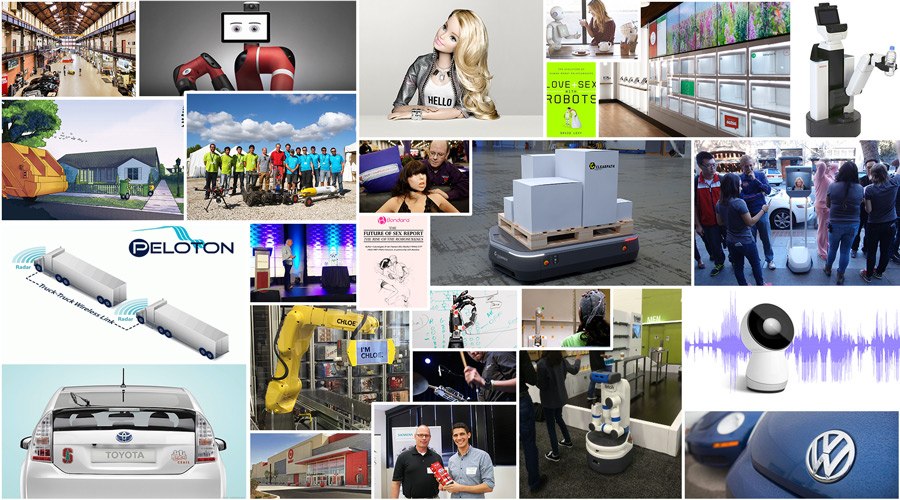
A quick, hassle-free way to stay on top of robotics news , our robotics digest is released on the first Monday of every month. Sign up to get it in your inbox.
Who’s driving?
Auto giant Toyota announced that it will invest $50 million to develop “advanced driving support” technology in partnership with MIT’s CSAIL and Stanford’s SAIL, and has hired Former DARPA Program Manager Gill Pratt as their new Executive Technical Advisor to direct the project. And Google announced former Hyundai CEO John Krafcik as its new self-driving car chief executive, a decision that could take this Google’s research enterprise one step closer to becoming an actual business.
Meanwhile, ride share service Uber hired two security experts — Charlie Miller from Twitter and Chris Valasek from IOActive, who in July demonstrated they could hack a moving Jeep — to join the growing team of researchers at their company’s Advanced Technologies Center in Pittsburg, notorious for having recruited dozens of experts from Carnegie Mellon University’s robotics department.
All the corporate interest would suggest that the technology is rapidly maturing, but is it a good thing for basic research? While the New York Times Magazine speculates whether high tech academia can survive poaching from Silicon Valley, others suggest that there will always be a need for early stage research that only university labs can cater to.
Cleaning up
Volkwagen made headlines when it was discovered that millions of their vehicles used software to cheat during emissions tests. Unfortunately this was not the first time an automaker used software to break the law. Brad Templeton muses on what the scandal means for the future of robocars.
On a tidier note, Volvo announced it would team up with the Chalmers University of Technology, Mälardalen University of Sweden, Penn State, and recycling company Renova to develop a new project called Robot-based Autonomous Refuse handling (ROAR). The hope is to have supervised robots collecting your garbage soon.
Meanwhile Peloton Technology, a developer of adaptive cruise control systems for trucks, cleaned up when they secured $17 million from several strategic investors, including Japanese robot maker Denso.
Retailing robots
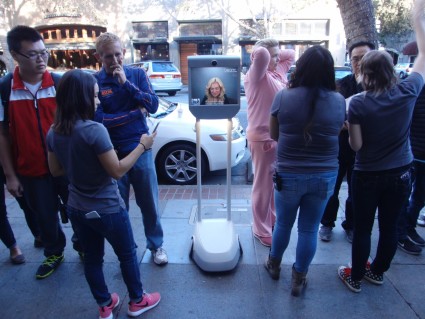
Using a BeamPro, Brianna Lempesis waits in line to buy an iPhone6s from the Apple Store in downtown Palo Alto. Photo: Suitable Technologies.
While department store giant Target announced plans to test robot workers in its upcoming concept store, Chloe the robot has already started work at Best Buy in New York city, and in San Francisco, at a fully automated restaurant called Eatsa, guests can order their meal via in-store iPads and collect their food from small glass compartments with no human staff in sight.
And robots aren’t just working behind the counter these days. This September shoppers used telepresence devices to queue up at their local Apple stores to buy the newly released iPhone 6S.
Talking robots
Mattel, manufacturer of the iconic Barbie doll, is planning to use AI to help conversational dolls to get to know their human playmates. Every little girl’s dream? Maybe, but critics have already raised concerns about the talking doll’s impact on privacy and gender perceptions.
Meanwhile, the makers of Jibo are working hard to make their social robot sound lifelike, and a chatbot named Rose came out tops to win the Loebner artificial intelligence prize despite not convincing the judges she was actually human.
The push towards conversational systems should not come as a surprise to anyone who attended RoboBusiness this year. In the keynote talk, IBM‘s Robert High posited that “Cognitive computing will be to computing what transaction processing is today.” (Check out more Robobusiness coverage, including Rethink’s Sawyer and the new OTTO from Clearpath here).
Winners’ circle
The Robot Launch international startup competition announced its winners this September. CleverPet’s smart pet feeder took first prize, with judges citing the how product’s adaptability and focus on play distinguished it from other robotic pet products. First runner up was Preemadonna’s Nailbot — a robot that lets you paint custom designs on your fingernails.
Meanwhile in Europe, euRathon — the world’s first outdoor land, sea and air disaster competition — came to an end. Using teams of land, air and sea robots, participants were required to locate missing workers, map a building and identify critical hazards, and inspect land and underwater pipes and stem a leak, all within 100 minutes. The multi-domain partnership Cobham (land), Universitat de Girona (sea) and ISEP/INESC TEC (Air) were crowned Winners of the Grand Challenge.
Fast moving prosthetics
Robotic prosthetics are fast becoming one of the most exciting developments in rehabilitation, giving hope to thousands of amputees. This was beautifully demonstrated in a short documentary exploring the life of ‘cyborg drummer’ Jason Barnes.
If you think those drumsticks are moving fast, so is the research. A hand developed at Johns Hopkins using DARPA technology gives its wearer sense of touch, and researchers from CNIB and EPFL have developed a brain-controlled prosthetic that learns from its mistakes, adapts to changing conditions, and speeds up the prosthetic training process for patients.
Hot and bothered
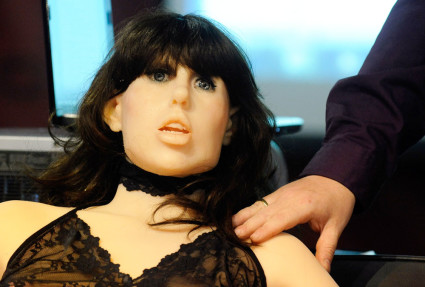 Nothing will generate headlines like sex. Except maybe robots and sex.
Nothing will generate headlines like sex. Except maybe robots and sex.
This September robot sex hit the news when robot ethicist Kathleen Richardson launched the Campaign Against Sex Robots. Drawing parallels between robot sex and prostitution, Richardson argued that sexbots reinforce asymmetrical relationships and could exacerbate gender inequalities. Others disagreed, arguing that fringe sex toys could hardly doom all of humanity to exploitation and empty relationships, and that they may offer a safe environment for fulfilling sexual fantasies.
Then, just when we thought the topic was going limp, a paper titled ‘The Future of Sex Report’ stoked the fire again by claiming that by 2050, people will be having more sex with robots than with each other.
All this pillow talk was clearly too much for some: SoftBank reportedly issued a clause in their purchasing contract that bans users from having sex with Pepper, and Malaysian authorities withdrew their support for the Love and Sex with Robots conference, which was planned for November.
Want tease out the finer points of the debate? Check out the Robot-Human Love episode from the Robots Podcast.
Events to watch for this October:
- RoboUniverse Tokyo – Tokyo, Japan – Oct 7-11
- Maker Faire Pittsburgh – Pittsburgh, PA, USA – Oct 10-11
- Maker Faire Seoul – Seoul, South Korea – Oct 10-11
- National Robot Safety Conference – Pittsburg, PA, USA – Oct 12-14
- International Collaborative Robots Workshop – Pittsburg, PA, USA, Oct 25
- Maker Faire Rome – Rome, Italy – Oct 16-18
- Robotics Innovation Show – London, UK – Oct 20-21
- International Conference of Social Robots in Therapy and Education – Almere, Netherlands – Oct 22-23
- International Conference on Social Robotics (ICSR) – Paris, France – Oct 26-30
- Field and Assistive Robotics 9 – Lahore, Pakistan – Oct 30 – Nov 1
Miss a previous digest? Don’t worry! Check out our archives.
tags: Robohub Digest


